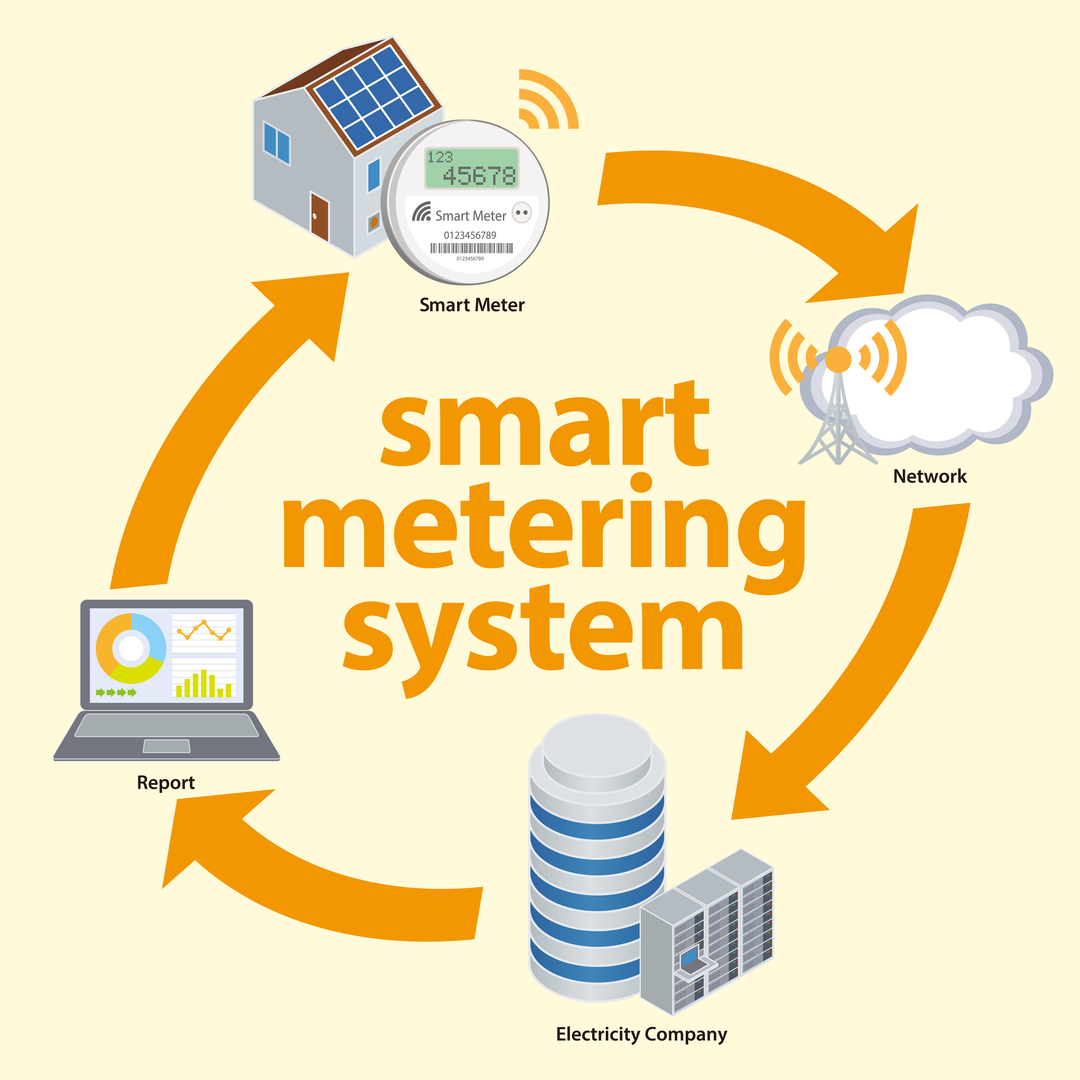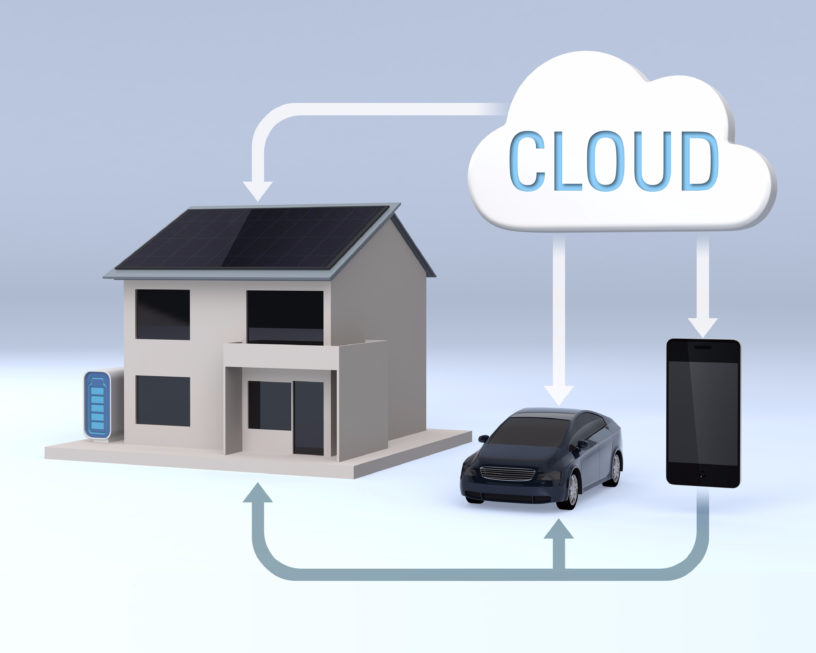The rollout of Smart Meters has always been seen as an obvious solution to measure kWh in real time and bill customers on a regular basis. From a consumer perspective, you can get a better understanding of your electricity usage with an online application. At first, you might even change your light bulbs, TV or fridge but at the end, you may just stop using it because you cannot interact with it. This is about to change with the increasing success of Photovoltaic panels (PV), home batteries (EES) and the rise of electric vehicles (EV).
What is a smart meter?
The description of a Smart Meter according to Wikipedia is an electronic device interconnected to an energy provider that records consumption of kWh for monitoring and billing. The data communication is generally ensured over a wireless connection with a 2-4G mobile data network with an M2M card (Machine to Machine), over the home area network (HAN) of consumers (WI-FI) or with a Power line communication (PLC). This PLC technology works with the transmission of signals on the electrical power lines. Usage reporting can afterwards be monitored over online software applications. Smart meters can also provide a two-way communication between the meter and the energy provider. It means that they can give or get electricity produced by photovoltaic panels or stored in batteries. That’s a game changer because it allows you to interact directly with your electrical grid.

Smart meter shall not be confused with smart home
What we call a smart home solution is an interconnected house which allows you to remotely control or program an array of automated home electronic devices such as lighting, heating, security cameras… Smart Meters, on the other hand, are primarily interconnected electrical meter to manage energy consumption with your energy provider. Even if some Smart Meter manufacturers have the ambition to get to the Smart Home market, these solutions are rather interesting for show rooms but not efficient in comparison with fully integrated Smart home solutions.
What are the reasons to get a Smart Meter?
The prime reason for an electric meter existence is to measure energy consumptions for Billing purposes. Smart Meters do offer far more benefits, especially if you are equipped with Photovoltaic panels and a battery solution. As you cannot buy a Smart Meter at your local electronics store, it is important to understand benefits for consumers but also the interest for your electricity supply companies (ESC).
Consumer benefits
- Better usage understanding with online monitoring. It is possible to see the direct impact of people habits and lifestyle on an energy bill. This can motivate consumers to take some optimisation measures such as changing old devices. For example, a 10 years old fridge can consume 20 to 50% more energy than newer ones.
- Cost management with accurate Billing: No bad surprises of estimated bills due to change of consumptions to expect. The electricity usage is calculated exactly and can be paid on a regular basis.
- Management of Photovoltaic (PV) and battery (EES) installation: Two-way power flows of energy enables you to see how many kWh are being sent back to the grid and how many could be needed or stored in a battery.
Energy company benefits
- Accurate and higher billing frequency: Estimated bills are not anymore needed as the data are sent online which allows regular billing. The result is a better cash intake (improved cash flow) thanks to frequent payments from customers.
- Improved Processes: The entire Meter-to-Cash (M2C) process which is the management of kWh from delivery to billing can be improved thanks to a complete end to end digitalisation.
- Diversity of price models: Online data exchange allows a bigger diversity of price models such as “Pre-Paid” or “Pay as you go” (PAYG) for temporary use such as holiday facilities (houses, apartments…).
- Direct cost reduction: No costs involved with on-site electricity meter reading.
- Energy saving improvements: Creating more energy conscious consumers by encouraging them to better manage and reduce energy usage. This can help utilities to reach carbon reduction targets.
- Two-way power flows: Electricity is delivered from the grid to the customer but also from the customer to the grid thanks to own decentralised PV energy production.
- Customer data management for energy forecasting. The energy provider gets the exact usage figures for energy provisioning on the trading market.
What are the future evolutions in relation with Smart Metering?
Smart Meter manufacturers are mostly selling meters based on innovation improvements for electricity productions, transmissions and distributions. These futuristic concepts are more than white paper materials, it’s actually happening:
- Load balancing in relation with Smart Grid: With the decentralisation of energy (PV, wind), energy companies could be interested in storing surplus of energies in home batteries and buying back this energy during peak hours. This is called load balancing. This concept for decentralised energy production and storage would be managed with an integrated smart meters and smart grid solution. Both systems would exchange data about energy demand for peak and off-peak production managing both solar (PV) and storage (EES) infrastructures.
- Dynamic pricing plans: Smart meter could communicate tariff changes according to production peaks and lows. This would automatically motivate/push customers to consume energies at given times. Example: Lunch time when the sun is at its peaks and demand is dropping could be ideal for charging your electric car.
- Smart Meter with price management: Least cost routing solutions which could be programmed to buy and store energy at the cheapest time and ESC to sell it back at the highest price could be a standard in the future.
- Smart home integration: Smart Meter capabilities could be used as an application on a software platform with other devices. Google with Alexa Smart home solution is going in this direction.
- Vehicle-to-Grid (V2G): The potential of millions of EV batteries being on standby for 90% of the day offers an interesting outlook for load balancing. The battery could be connected to the grid and be used as temporary energy storage facilities.
What is slowing down the rollout of Smart Meters?
Even if there are a lot of Smart Meters roll out projects around the world, the “big bang” hasn’t happened yet. The reason is that there are still multiple risks and challenges involved:
- Data communication transmission difficulties: Electric meters are often placed in home basements with bad wireless receptions. This can also be very challenging in remote places without any communication networks. Power line communication (PLC) is a complex technology requiring important investments.
- Transition period with old equipment’s: Energy providers will have to manage both old and new electric meters infrastructures for a transitional period of 5 to 10 years. This means double maintenance and management processes to maintain.
- Evolving standards and regulations: Technological and regulatory requirements are constantly evolving. We can see the example of first generation meters (SMETS1) which are not anymore compatible with all suppliers.
- Smart meter price: Meter investment costs with running charges (maintenance and communication) can make the case challenging.
- Challenging Return on Invest (ROI): The current business case is based on interest rates income with quicker cash intake, labour service savings for meter reading and lower service costs (ex: reduction of billing complaints). However, the price of labour for meter reading can be in some countries too low in comparison with communication and maintenance cost of Smart Meters. Surprisingly this is the case in Switzerland according to a colleague of a major ESC.
- Market readiness: New innovations with Smart Grid technologies are not yet supported which makes it difficult for potential investments.
- Project Planning: Rollout of millions of smart meters requires costly and complex project management. Project team capacity is mostly underestimated with millions of homes to equip.
Large Smart Meters roll out might not be yet a reality everywhere but the transformation of energy with PV, EES and EV’s will be a major trigger in the coming years. Future features such as load balancing and dynamic pricing are made to support this evolution in the next 5 years.





Leave a Reply